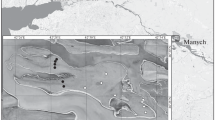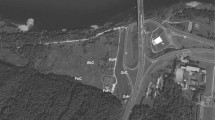Abstract
The results of a long-term study of changes in soils and vegetation during postagrogenic succession of sown meadows on reclaimed peat soils (Eutric Histosols) are presented. The study was performed on experimental plots in the Korzinskaya Lowland (Karelia); sowing of perennial grasses was accompanied by the application of mineral fertilizers. Observations over changes in the vegetation communities along with the reduction of the peat thickness were conducted. The soil samples were analyzed for the organic carbon, total nitrogen, and available phosphorus contents and for the pH of salt extracts. Vegetation was described using the Braun-Blanquet approach; the botanical composition and the biomass of herbs were assessed by their cutting and weighing. Nematode communities were characterized by their taxonomic diversity, population density, and eco-trophic structure. The analysis of soil profiles demonstrated that the thickness of the peat deposits decreased over 40 years of observation (1974–2015). The direction of vegetation succession on sown meadows was dictated by the type of fertilization. Two plant communities were formed: Deschampsieta caespitosae humidiherbosum developed on the plots treated with mineral fertilizers, and Elytrigeto magnograminosoherbosum community developed on the plots treated with mineral and organic fertilizers. The main changes in soil nematode communities during the long-term succession were related to their eco-trophic structure. Two trophic groups exhibited an obvious response: the relative abundance of nematodes associated with plants decreased, whereas the share of plant-parasitic nematodes increased. In addition, it was found that the species composition of herbs predetermined the ecological specialization of dominant plant-parasitic nematode taxa.

Similar content being viewed by others
REFERENCES
V. A. Bukhman and M. M. Tsyba, Agrochemical Properties and Fertility of Peat Soils of Karelia (Petrozavodsk, 1967) [in Russian].
L. I. Gruzdeva, E. M. Matveeva, and T. E. Kovalenko, “Changes in soil nematode communities under the impact of fertilizers,” Eurasian Soil Sci. 40, 681–693 (2007).
L. I. Gruzdeva and A. A. Sushchuk, “Trends of nematode community recovery after soil cover degradation,” Biol. Bull. (Moscow) 37, 647–652 (2010).
I. A. Dubrovina and T. V. Bogdanova, “Korza Research Station: half a century of serving to science,” Tr. Karel. Nauchn. Tsentra, Ross. Akad. Nauk, No. 6, 3–15 (2016).
T. S. Eliseeva and L. G. Kozlov, “Species composition of vegetation cover of seeded meadows on dried peat lands,” in The Structure and Productivity of Natural and Seeded Meadows (Karelian Branch, Academy of Sciences of USSR, Petrozavodsk, 1980), pp. 19–28.
L. L. Shishov, V. D. Tonkonogov, I. I. Lebedeva, and M. I. Gerasimova, Classification and Diagnostic System of Russian Soils (Oikumena, Smolensk, 2004) [in Russian].
Classification and Diagnostics of Soils of the USSR (Kolos, Moscow, 1977) [in Russian].
N. V. Kokorina, “Evaluation of biological diversity of floodplain phytocenoses,” Vestn. Yugorsk. Gos. Univ., No. 3 (14), 44–51 (2009).
E. M. Matveeva and A. A. Sushchuk, “Features of soil nematode communities in various types of natural biocenoses: effectiveness of assessment parameters,” Biol. Bull. (Moscow) 43, 474–482 (2016). https://doi.org/10.7868/S0002332916040093
Practical Manual for the Experiments in Hayfields and Pastures (All-Russian Williams Fodder Research Institute, Moscow, 1961) [in Russian].
B. M. Mirkin, G. R. Khasanova, L. M. Abramova, and Ya. T. Suyundukov, “Successions in the crops of perennial plants: pattern and input into biodiversity and resistance of agroecosystems,” Byull. Mosk. O-va. Ispyt. Prir., Otd. Biol. 107 (4), 39–45 (2002).
I. A. Panchenkova, “Study and modern state of meadows of Volga Upland,” Vestn. Orenb. Gos. Univ., No. 6 (112), 16–18 (2010).
A. P. Sizykh and V. I. Voronin, “Soil-geobotanical profiling in studies on communities of the forest-extrazonal steppe junction and zonal forest-steppe (the Baikal region),” Russ. J. Ecol. 44, 93–99 (2013).
E. I. Sin’kevich, Doctoral Dissertation in Agriculture (St. Petersburg, 1997).
G. I. Solov’eva, Ecology of Soil Nematodes (Nauka, Leningrad, 1986), pp. 5–14.
A. A. Strelkova, N. E. Marchenkova, E. M. Perevozchikova, G. K. Kyabeleva, M. P. Amozova, and N. N. Pavlova, “Spatial variation of agrochemical properties of arable peat lowland soils,” in Soils of Karelia and Their Melioration (Karelian Branch, Academy of Sciences of USSR, Petrozavodsk, 1982), pp. 49–62.
Theory and Practice of Chemical Analysis of Soils, Ed. by L. A. Vorob’eva (GEOS, Moscow, 2006) [in Russian].
E. A. Shvarts, Conservation of Biodiversity: Communities and Ecosystems (KMK, Moscow, 2004) [in Russian].
G. S. Shushpannikova, “Formation and degradation of meadows under the impact of hay harvesting and grazing in the Vychegda and Pechora floodplains,” Russ. J. Ecol. 45, 33–37 (2014).
M. G. Yurkevich, “Horizontal structure of agrocenoses of Southern Karelia,” in Ecology and Geography of Soils (Karelian Scientific Center, Russian Academy of Sciences, Petrozavodsk, 2009), pp. 105–116.
S. M. Adl, D. C. Coleman, and F. Read, “Slow recovery of soil biodiversity in sandy loam soils of Georgia after 25 years of no-tillage management,” Agric., Ecosyst. Environ. 114, 323–334 (2006). https://doi.org/10.1016/j.agee.2005.11.019
J. van Bezooijen, Methods and Techniques for Nematology (Wageningen University Press, Wageningen, 2006).
T. Bongers, “The maturity index: an ecological measure of environmental disturbance based on nematode species composition,” Oecologia 83, 14–19 (1990). https://doi.org/10.1007/BF00324627
H. Ferris, T. Bongers, and R. G. M. de Goede, “A framework for soil food web diagnostics: extension of the nematode faunal analysis concept,” Appl. Soil Ecol. 18, 13–29 (2001). https://doi.org/10.1016/S0929-1393(01)00152-4
Ø. Hammer, D. A. T.Harper, and P. D. Ryan, “Past: paleontological statistics software package for education and data analysis,” Paleontol. Electron. 4 (1), 1–9 (2001). http://palaeo-electronica.org/2001_1/past/ i-ssue1_01.htm
IUSS Working Group WRB, World Reference Base for Soil Resources 2014, International Soil Classification System for Naming Soils and Creating Legends for Soil Maps, World Soil Resources Reports No. 106 (UN Food and Agriculture Organization, Rome, 2014).
P. Kardol, T. M. Bezemer, A. van der Wal, and W. H. van der Putten, “Successional trajectories of soil nematode and plant communities in a chronosequence of ex-arable lands,” Biol. Conserv. 126, 317–327 (2005). https://doi.org/10.1016/j.biocon.2005.06.005
B. Kempen, D. J. Brus, and J. J. Stoorvogel, “Three-dimensional mapping of soil organic matter content using soil type-specific depth functions,” Geoderma 162, 107–123 (2011).
R. Kõlli, O. Ellermäe, T. Köster, I. Lemetti, E. Asi, and K. Kauer, “Stocks of organic carbon in Estonian soils,” Est. J. Earth Sci. 58, 95–108 (2009).
U. Raabe and D. Brandes, “Flora und Vegetation der Dörfer im nordöstlichen Burgenland,” Phytocoenologia 16 (2), 225–258 (1988).
T. Robertson, C. Rosenzweig, V. Benson, and J. R. Williams, “Projected impacts of carbon dioxide and climate change on agriculture in the Great Plains,” in Proceedings of the International Conference on Dryland Farming “Challenges in Dryland Agriculture: A Global Perspective” (Bushland, TX, 1993), No. l, pp. 675–677.
M. Viketoft, B. Sohlenius, S. Boström, C. Palmborg, J. Bengtsson, M. P. Berg, and K. Huss-Danell, “Temporal dynamics of soil nematode communities in a grassland plant diversity experiment,” Soil Biol. Biochem. 43, 1063–1070 (2011). https://doi.org/10.1016/j.soilbio.2011.01.027
L. Wasilewska, “Changes in the structure of the soil nematode community over long-term secondary grassland succession in drained fen peat,” Appl. Soil Ecol. 32 (2), 165–179 (2006).
L. Wasilewska, “Impact of human activities on nematode communities in terrestrial ecosystems,” in Ecology of Arable Land—Perspectives and Challenges (Springer-Verlag, Dordrecht, 1989), pp. 123–132.
L. Wasilewska, “Soil invertebrates as bioindicators, with special reference to soil-inhabiting nematodes,” Russ. J. Nematol. 5 (2), 113–126 (1997).
G. W. Yeates, T. Bongers, R. G. M. de Goede, D. W. Freckman, and S. S. Georgieva, “Feeding habits in soil nematode families and genera: an outlain for soil ecologists,” J. Nematol. 25 (3), 315–331 (1993).
G. W. Yeates, D. A. Wardle, and R. N. Watson, “Relationships between nematodes, soil microbial biomass and weed-management strategies in maize and asparagus cropping systems,” Soil Biol. Biochem. 25 (7), 869–876 (1993). https://doi.org/10.1016/0038-0717(93)90089-t
Funding
The study was carried out under state order to Karelian Research Centre, Russian Academy of Sciences (project nos. 0218-2019-0075 and 0218-2019-0079).
Author information
Authors and Affiliations
Corresponding author
Ethics declarations
The authors declare that they have not conflict of interest.
Additional information
Translated by T. Chicheva
Rights and permissions
About this article
Cite this article
Yurkevich, M.G., Sushchuk, A.A., Matveeva, E.M. et al. Changes in Soil Nematode Communities during Postagrogenic Transformation of Peat Soils and Vegetation. Eurasian Soil Sc. 53, 686–695 (2020). https://doi.org/10.1134/S1064229320050166
Received:
Revised:
Accepted:
Published:
Issue Date:
DOI: https://doi.org/10.1134/S1064229320050166




